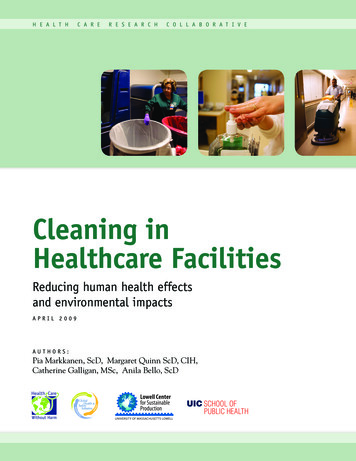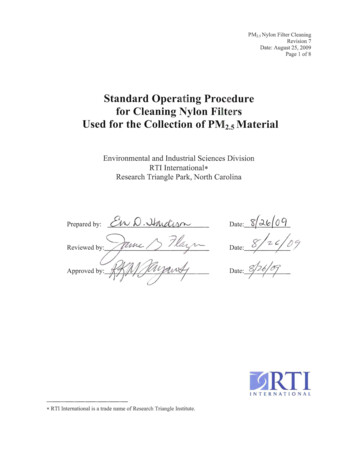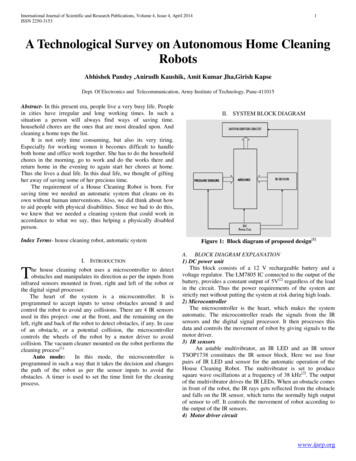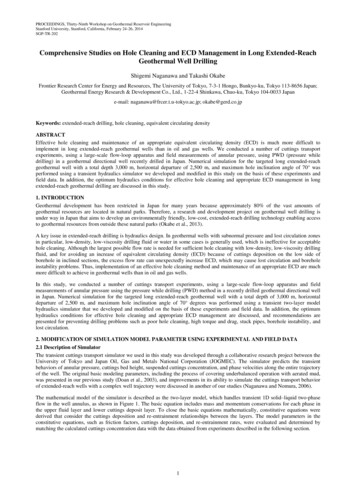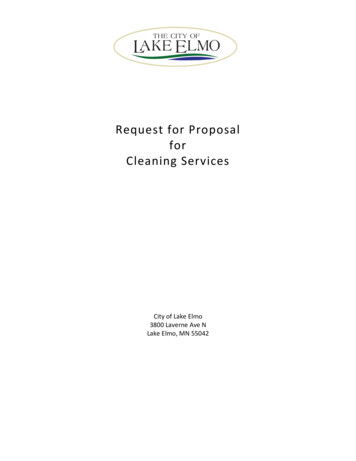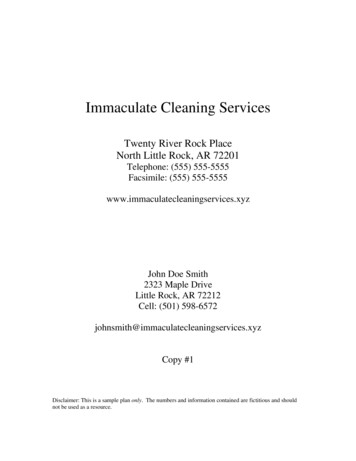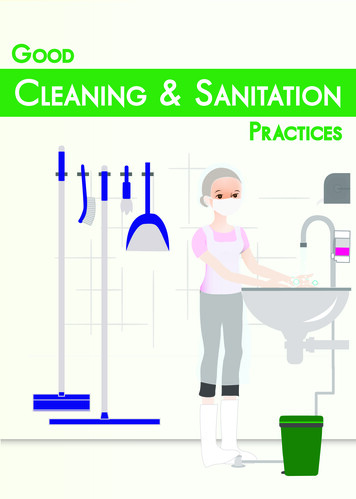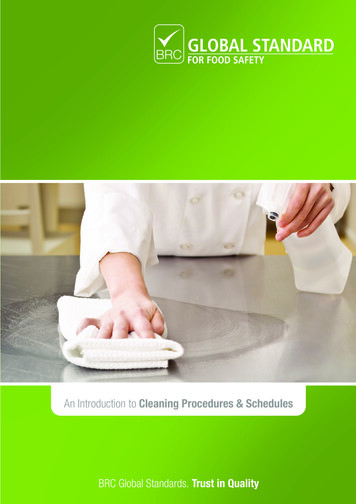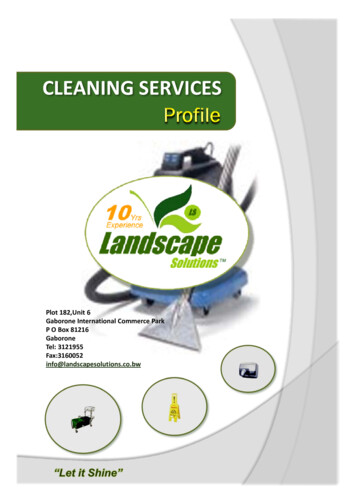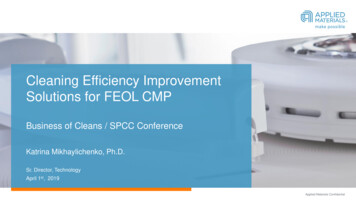
Transcription
Cleaning Efficiency ImprovementSolutions for FEOL CMPBusiness of Cleans / SPCC ConferenceKatrina Mikhaylichenko, Ph.D.Sr. Director, TechnologyApril 1st, 2019Applied Materials Confidential
CMP Mechanism and Cleaning Challenges Three-body interaction: Wafer, Pad, Slurry Slurry: Complex suspensions containingabrasive particles, stabilizing agents andinhibitors Pad & abrasive remove inhibitor(a) from highpressure areas Remaining inhibitor(a) protects low areas. After polish layer cleared from stop layer,inhibitor(b) protects stop area and inhibitor(a)represses dishing of oxide in trenches Polishing by-products (chemical reactants,agglomerated slurry and pad/conditionerdebris) are present on wafer after polish andneeds to be removed during post-CMP cleans2Applied Materials Presented at Business of Cleans / SPCC 2019
Particle Removal and Re-DepositionParticle RemovalParticle attached on wafersurfaceParticle DepositionBreaking van der Walls forces: Undercutting by HF Shear force by brush scrub,Megasonics, Fluid jet Lift off by repulsive forces: Shear force by brush scrub,Megasonics, Fluid jet Electrostatic forcesVan der Walls interactions:rapid deposition of particlesclose to the surfaceDiffusion of particles to surfacedue to overall attraction forceand electrostatic force Particle removal: interaction force between the particle and the substrate has to be eliminated by shear force: Fluid shear flow, Brush scrub, Megasonic cleaning, Fluid jet Chemical etching is used to assist with breaking the particle-surface bond Undercut on the substrate and/or wet etch of the particle After breaking the bond, the particle has to be removed away from the surface to prevent re-attachment3Applied Materials Presented at Business of Cleans / SPCC 2019
Post CMP Cleaning Trends What stays the same? Key Post CMP Clean TechnologiesChemical MechanicalBuff with Soft PadDouble Sided BrushScrubNon-Contact Cleans:Megasonic or Fluid JetMarangoni DryPost CMP Wet Clean(SPM)Dehydration process:H2SO4 H2O2 H2SO5 (Caro's acid) H2OFormatioon of atomic oxygenH2SO4 H2O2 H3O HSO4 OHighest shear forceChemical CleanGoal: High PREBreak particle-surface bond4High sheer force ChemicalCleanGoal: High PREBreak particle-surface bondApplied Materials Presented at Business of Cleans / SPCC 2019Low shear forceChemical CleanGoal: Low adderNo re-contaminationSurface tension gradientbased dryingGoal: No addersNo watermarksAggressive ChemicalCleanGoal: Ce ion removal,Organics removal
Post CMP Cleaning Trends What’s Different? Clean Technologies’ Implementation Decrease in the critical particle size drives more stringent cleaning efficiency requirements Wide adoption of Chemical Mechanical Buff “Easy to clean” applications now require cleaning efficiency improvements PreCleanTM initially adopted for FEOL; adopted in HVM for BEOL in 2018; great interested for WMG in 2019 Advanced metrology techniques Novel Cleaning Chemistries drive HW compatibility specifications Post CMP Wet Clean elimination: SPM replacement Custom approaches and system flexibility requirements Multiply films exposed require optimized module sequence and recipe structure Tool box of Cleaning Options, which can be easily used based on specific applications and issues5Applied Materials Presented at Business of Cleans / SPCC 2019
Particle RemovalzU(z)Liquid Flow field Adhesion moment Function of adhesion force (van der Waals), particle geometry Proportional to particle radius Removal Moment:FLFASubstrateFtMD Function of shear force, double layer interactions, particle geometry Proportional to square of particle radiusFDMAFD – The Drag forceFA – the Adhesion forceFL – the Lift forceFt – the tangential frictionWvdw 6Applied Materials Presented at Business of Cleans / SPCC 201912 HFdrag 8 o ( D ) 2 s shear viscosity 0 shear �) 𝑀𝑜𝑚𝑒𝑛𝑡𝑀𝑅 𝐴𝑑ℎ𝑒𝑠𝑖𝑜𝑛 𝑀𝑜𝑚𝑒𝑛𝑡For MR 1, a certain % of particles canbe removed 2C 2 DSmaller particles are more difficult to remove
Cleaning Efficiency Comparison on “Easy to Remove” Particlesfor Individual Cleaner Modules100%90%80%70%60%50%40%30%20%10%0%Cleaning Efficiency PreAll modules run with 2.0 wt% NH4OHMegasonic TankMegasonic NozzleBrush CleanPreCleanChallenge wafers: Spin-on SiN particleson TEOS filmContact Clean methods demonstrate high particle removal efficiencyBrush shear force is sufficient to remove 99% of the particles7(Pre – Post)Applied Materials Presented at Business of Cleans / SPCC 2019
Cleaning Efficiency Comparison on Post CMP DefectsPolish B1/B2Polish Meg B1/B2Polish PreClean B1/B2Brush shear force is NOT sufficient to remove strongly attached particlesAdding Chemical Mechanical buff in PreClean module improves defects 100XAdding Megasonic tank clean does not improve defectsPolisher: Asahi Ce slurry / VP50xx pad / PreClean: Acidic Clean Chemistry / BKM pad / Meg:DIW, BB1:acidic clean, BB2:DIW8Applied Materials Presented at Business of Cleans / SPCC 2019
Why Non-Contact Clean is Needed?Bare Si @ 23nm / Cleaner onlyPre 3459Post 453Removed 3129B1/SC1 DryerB1/SC1 Non-Contact SC1 DryerAdded 121Post Pre - Removed AddedBrushes scrubbing removes butalso adds particlesSource of adders: Loose particlessuspended in liquid boundary layer onwafer surface9Applied Materials Presented at Business of Cleans / SPCC 2019Non-Contact Clean after brush scrubreduces adders by 50%Non-Contact Clean benefits: When used before contact clean, Non-ContactClean prevents media loading When used after the brush, Non-Contact Cleanreduces re-contamination from brush
Ce Slurry Cleaning ChallengeSlurry particle contamination remains high after conventional Brush ScrubNano-Particles ( 50nm size) cause patterning issues at subsequent level (shorts, opens)10Applied Materials Presented at Business of Cleans / SPCC 2019
Advanced Metrology Techniques Needed to Detect Nano-Ceria ICP-MS Ce detection is a sensitive method to quantify Ceparticle contamination below the SP5/SP7 sensitivity limits VPD ICP-MS analysis is a 3-step process: Decomposition of oxide layer using HF vapor: SiO2 6HF H2SiF6 2H2O H2SiF6 SiF4 2HF Trace metals in oxide layer form water soluble fluorides; these arecollected by scanning process Fe2O3 6HF 2FeF3 3H2O Cerium fluorides has poor flexibility. Specialty acid blend is used toensure complete collection of Ce-containing compounds Post scanning, VPD droplet is collected and analyzed by ICP-MSCombination of laser scattering techniques (SP5/SP7) and ICP-MS isused for Ce Cleans development11Applied Materials Presented at Business of Cleans / SPCC 2019
Integrated Ceria Cleaning Solution Applied Materials is developing an integrated (within CMP cleaner) ceria cleaningsolution to eliminate post-CMP wet cleaning ComparisonBenefits of Integrated non-SPM/non-HFCeria Cleaning ApproachChallenges of Current Industry POR (post CMP wet clean process)SPM long process time: 3min/wafer - 20wph/chamber - 240wph/system (12 chambers/system)Additional integration steprequired longer cycle time & fab floorspace Hazard / Toxic of hot SPM/HFrequired additional handling & facilitiesrequirements Cost of Hot SPM UsageSPM CoC raw material wastetreatment handling within the fab Eliminates need for post-CMP wet clean:cycle time, fab space & SPM/HF CoC Avoids additional handling and facilitiesrequirements of SPM for CMP systemsApplied is focused on an Integrated non-SPM/non-HF Ceria Cleaning Solution12Applied Materials Presented at Business of Cleans / SPCC 2019
Non-HF Solution is Needed to Replace SPM CleansPost CMP Ce Removal Screening: HF Brush ScrubPlaten Buffed Wafer Re-cleaned with HF ScrubbingCe ion concentration, E10 atoms/cm 26 E10Platen Buff with acidic complexing chemistry, 6.2E101.9 E10 70A TOX removal isneeded to reduce Ceconcentration to 1E9 atoms/cm2 with HFscrub10.27 E10Target: 1E9 atoms/cm2 surface Ce0.10.04 E100.010102030405060708090100Oixde Removal Amount, ÅHF is a poor choice for post CMP ceria removal13Applied Materials Presented at Business of Cleans / SPCC 2019110
Ce Slurry Cleaning Challenge for High Oxide Removal CMPPost CMP Piranha Clean can dissolve CeriaparticleszU(z)Liquid Flow fieldPiranhaWet benchFLFASubstrateFtMDFD – The Drag forceFA – the Adhesion forceFL – the Lift forceFt – the tangential ���𝑔) 𝑀𝑜𝑚𝑒𝑛𝑡𝑀𝑅 𝐴𝑑ℎ𝑒𝑠𝑖𝑜𝑛 𝑀𝑜𝑚𝑒𝑛𝑡For MR 1, a certain % of particles canbe removedAMAT approach: replace chemical reaction with chemically assisted high shear force cleaning14Applied Materials Presented at Business of Cleans / SPCC 2019
Integrated Ceria Cleaning SolutionSplitBrief conditionsSP5 @45nmCeria Particles(defect review/ classification)1-4(No Buff)Polish & Brush Box w/ Range ofCleaning Chemistries20,000 to 50,000 200 (est.)5Polish w/ Platen Buff w/ Chem Y180 to 280Did not measure6Polish w/ PreClean w/ Chem Y21547Polish w/ PreClean w/ Chem X127None FoundNotesChemistries can help, but notsufficientHigh PRE Buff makes significantimprovementPreClean Shows SimilarPerformance to Platen BuffChemistries in PreClean canimpact performanceSplit 6 Previous BKMPreClean w/ Chem YSplit 7 CnFPreClean w/ Chem XC&F of a Non-SPM/Non-HF Integrated Ceria Cleaning Solution15Applied Materials Presented at Business of Cleans / SPCC 2019Versum STI24xx / Nexplanar 60YY Polish
Non-SPM Clean PerformanceCe Ion Concentration by VPD ICP-MSDefects by SP5Ce Ion Concentration, atoms/cm21.00E 111.00E 101.00E 09Target: 1E9 atoms/cm2surface CeSplit 7: New ApproachPreClean Chem XSplit 6: Previous BKMPreClean Chem Y1.00E 08Split 7: New ApproachPreClean Chem XSplit 6: Previous BKMPreClean Chem YSplit 7: New ApproachSplit 6: Previous BKM10-15X improvement in Ce ion surface concentration with new approach50% improvement in defect performance on TEOS16Applied Materials Presented at Business of Cleans / SPCC 2019Versum STI24xx / Nexplanar 60YY Polish
Addressing Post CMP Cleaning Challenges in LK PrimeTM System Cleaner: 5x Side-by-Side Cleaner Stations Megasonics Provides physical force to remove contamination form the features Provides full wafer immersion tank for bevel contamination removal PreClean Provides means to perform chemical buff in a dedicated slurry-free module Vertical buff enables effective contamination removal off the surface Enable cleaning of top surface of the wafer bevel Two consecutive brush boxes provide high particle removal efficiencyand precise brush pressure control Vapor Dryer provides defect-free drying of hydrophilic, hydrophobic andmixed surfaces Cleaner Chemical Flexibility enables particle undercut and lift-off HF-compatible brush box enables SiO2 substrate etching Proprietary chemicals often include particle etch capability17Applied Materials Presented at Business of Cleans / SPCC 2019
AMAT CMP Defect Improvement Tool BoxModuleFeatureBenefitMechanismHCLUChemical Rinse duringpolish to clean transitionImproved defectivity for Poly/ Si CMPImproved wetting on hydrophobic films(Poly, BDIII)PreCleanSoft Pad buffSignificant reduction indefectsParticle removal efficiency with highshear forceSpecialty Spray BarsEdge signature excursioncontrolOptimized chemical distribution to waferedgeSteadyCleanExcursion controlBrush life improvementConsistent sheer force over brush lifeBB2.0Excursion controlBrush life improvementIn-situ brush cleaningHF/Ozone BBSignificant reduction indefects for HF-Last CMPSurface conversionOrganics reductionMultistep BB recipeReduction in defectsCombination of brush open/ close stepsVD1.5TPT ImprovementN2/IPA Spray optimizationBrush BoxDryerReady to Engage to Develop/Optimize a BKM for Customers (i.e., your wafers and consumables)18Applied Materials Presented at Business of Cleans / SPCC 2019
Chemical Rinse in HCLU: Poly CMPObjective: Convert Hydrophobic poly surface to Hydrophilic assoon as possible after polish step to prevent strongbonding of residues onto surfaceStrategy: Rinse wafer surface in HCLU with surfactant-containingcleaning chemistryAbout 10X improvement in defectsfrom adding chemical rinse in HCLUwas observedPolish: Silica slurry polish / HCLUl: acidic cleaning solution / PreClean: acidic cleaning solution19Applied Materials Presented at Business of Cleans / SPCC 2019
PreClean Module for Chemical Mechanical BuffChallenge: Nano-Particles ( 50nm size) causepatterning issues at subsequent level(shorts, opens) Buffing in polisher impacts TPUTApproach: Move chemical buffing frompolisher to cleaner Vertically orient to leverage one-passchemical usage and avoid particlere-attachment and scratchingApplied’s Solution: Soft Pad Chemical Buff in the CleanerP1: Asahi ceria slurry, Vision pad; P2/PreClean: Fujimi acidic chemistry, DIW Meg; BB1: CX100; BB2: DIWChemical Mechanical Buff with optimized chemistry is needed for FEOL CMP20Applied Materials Presented at Business of Cleans / SPCC 2019
Brush Box Spray Bar CIPChemical Coverage Uniformity ImprovementProblem Statement Chemical etch (coverage) nonuniformity with brush-closedprocess due to brush andchemical spray interferencesTOX Removal with60Brush-Closed ProcessOxide removed (A)50403020Old1500mlSpray50rpmbar; 1500 mL/min chem flowPOR10ShowerHVMbar; 1500 mL/min chem flowSAHVM 3.0Style1500ml30 rpm0Solution Optimized shower style spray bar21Applied Materials Presented at Business of Cleans / SPCC 2019-150-100-50050100Position (mm)Shower style HVM spray bar improves range by 3XReleased for LK PrimeTM and LK3.0150
Ozonated Water Clean for Oxide and Poly PolishCircularScratchesOrganics ReductionObjective: DIO3 Rinse in BB1, Prior to Chemical ScrubDIO3 RinseDIW RinseRemove organic contamination with Ozonated Water CleanStrategy: Implement DIO3 rinse in Brush Box (BB1 or BB2) Supply DIO3 through DIW rinse spray bars Reduce O3 concentration to 10 ppm for brush compatibility Remove brushes to eliminate interactions with DIO3 if higherO3 concentration is neededDIO3 Rinsein BB1DI Water Rinsein BB1Status: Implemented in Si CMP BKM: NH4OH HF/DIO3 Released for LK PrimeTMDefect reduction with DIO3 is due to reduction insurface Carbon and Si surface conversion2222 Applied Materials Presented at Business of Cleans / SPCC 20193x improvement observed with DIO3
SteadyClean: Advanced Brush Torque ControlChallenge: Brush Shear Force FluctuationsChallenge : For small brush gap compression processes ( 0.5mm),variations in roller brushes & mechanical setup lead tounstable particle cleaning and/or short brush lifetimes.Approach: Maintain consistent brush shear force on wafer surface bydynamically changing brush spacing to keep brush motortorque consistentBenefit: Consistent brush PRE for stable particle defectperformance and longer brush lifetimes.Control Shear Force for Consistent Roller Brush PRE23Applied Materials Presented at Business of Cleans / SPCC 2019Approach: Consistent Brush Motor TorqueKeeps net brush torque stable over 2000 wafersCompensates for environmental changes bydynamically changing brush spacing
Vapor Dry 1.5Residual waterSi @ 45nm Objective:– High speed vapor drying process tosupport short polish times– More robust Drying Strategy:– Optimized spray bar position and angleas well as N2-IPA flowbBSbFSTEOS @ 65nm– Modified angle, height and spacing ofspray bars to front and back Status:– 29 sec BKM with new bars equivalent to52 sec BKM with old bars– Available on LK and LK PrimeTMHDBSInputs Angle Height Distance N2/IPA flow rateDFSOutputs Defects Wetness Touch-pointOptimized IPA spray bar (VD1.5) enables high speed dry on hydrophilic substrates24Applied Materials Presented at Business of Cleans / SPCC 2019
CMP Defect Improvement Tool BoxModuleFeatureBenefitMechanismHCLUChemical Rinse duringpolish to clean transitionImproved defectivity for Poly/ Si CMPImproved wetting on hydrophobic films(Poly, BDIII)PreCleanSoft Pad buffSignificant reduction indefectsParticle removal efficiency with highshear forceSpecialty Spray BarsEdge signature excursioncontrolOptimized chemical distribution to waferedgeSteadyCleanExcursion controlBrush life improvementConsistent sheer force over brush lifeBB2.0Excursion controlBrush life improvementIn-situ brush cleaningHF/Ozone BBSignificant reduction indefects for HF-Last CMPSurface conversionOrganics reductionMultistep BB recipeReduction in defectsCombination of brush open/ close stepsVD1.5TPT ImprovementN2/IPA Spray optimizationBrush BoxDryerReady to Engage to Develop/Optimize a BKM for Customers (i.e., your wafers and consumables)25Applied Materials Presented at Business of Cleans / SPCC 2019
Summary Geometry shrinking and new material implementation in advanced nodes demand theachievement of high particle removal efficiency To address cleaning challenges in various nodes, Applied CMP Clean technology continues toevolve and includes broad portfolio of cleaning techniques Optimized post polish rinse High shear force PreClean module for high particle removal efficiency Single wafer Megasonic module for improving defect removal efficiency HF-compatible dual brush box module with Improved chemical coverage uniformity SteadyClean Brush Torque (Shear Force) Control for Consistent Roller Brush PRE Ozonated Water Rinse for Organic Defect Reduction BB2.0 Brush Conditioning for Extended Brush Life Single wafer IPA dryer for achieving water-mark free drying at high speed (with VD1.5 option)Optimized Solutions Require the Right Approach (Process Modules)and the Right Process (Process Engineers/Applied)26Applied Materials Presented at Business of Cleans / SPCC 2019
27
ICP-MS Ce detection is a sensitive method to quantify Ce particle contamination below the SP5/SP7 sensitivity limits VPD ICP-MS analysis is a 3-step process: Decomposition of oxide layer using HF vapor: SiO 2 6HF H 2 SiF 6 2H 2 O H 2 SiF 6 SiF 4 2HF Trace meta

